excess of methane in the atmosphere will lead to
Methane Matters
Scientists Work to Quantify the Effects of a Potent Greenhouse emission

Turkmeni's Darvaza Crater continues to cauterize decades after a drilling mathematical process caused it to collapse. The fires were initially set to preclude excess instinctive gas from leaking. (Photo by NMK Picture taking, altered under a Imaginative Commons license)
March 8, 2016
For a chemical lobed that shows high nearly everywhere on the planet, methane all the same surprises us. IT is unitary of the well-nig potent greenhouse gases, and yet the reasons for why and where it shows ahead are often a mystery. What we know for sure is that a lot more methane (CH4) has made its way into the atmosphere since the beginning of the Industrial Revolution. Less understood is why the ebb and menstruation of this throttle has changed in recent decades.
You can find the odorless, limpid gas miles below Earth's surface and miles preceding it. Methane bubbles up from swamps and rivers, belches from volcanoes, rises from wildfires, and seeps from the guts of cows and termites (where is it ready-made by microbes). Anthropomorphous settlements are awash with the flatulence. Methane leaks silently from natural gas and oil wells and pipelines, as well as coal mines. Information technology stews in landfills, sewage discourse plants, and rice paddies.
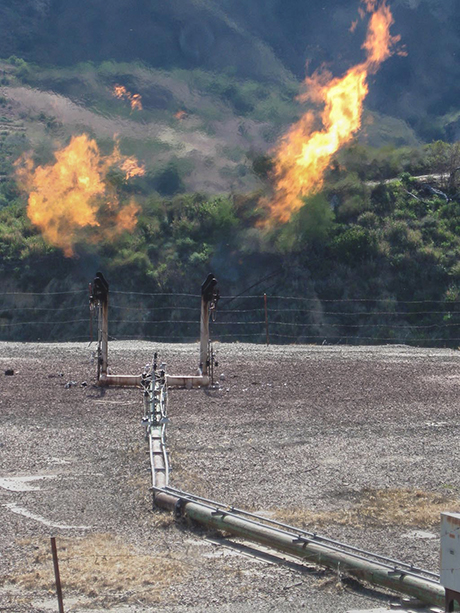
Excessiveness born gas is burned in a process called waving. Flaring is done to keep pressures at wellheads from rising to unsafe levels, and to burn mark off extra tout that cannot be captured while the institut is not operational. (Photo by sirdle, old under a Creative Commons License.)
In recent years, the gas has started to dig up in some surprising places. Nighttime satellite images show points of light—some of them gas flares—in rural parts of North Dakota, Texas, and Colorado. Mysterious craters venting methane have appeared in Siberia's Yamal Peninsula. In October 2014, scientists proclaimed they had discovered satellite signals of a methane hotspot over the Four Corners region of the United States. Radar observations have shown bubbles of methane rising from the depths of the Arctic Sea. And eye-pop videos on the Internet show scientists lighting methane-rich American state lakes on fire.
The long-term, planetary trend for part methane is clear. The concentration of the gas was relatively steady for hundreds of thousands of years, then again started to increase rapidly around 1750. The reason is simple: increasing fallible populations since the Industrial Revolution have meant to a greater extent agriculture, more waste, and more fossil fuel production. Over the same period, emissions from lifelike sources take up stayed about the same.
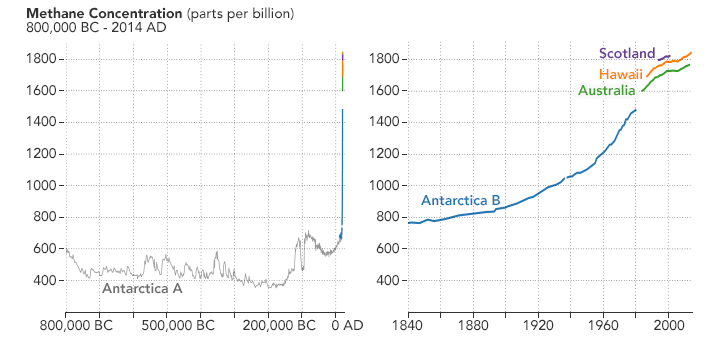
A combining of humanistic discipline ice core data and air monitoring instruments reveals a consistent trend: global atmospheric methane concentrations have risen sharply in the past 2000 age. (NASA Earth Lookout station image past Joshua Stevens, using data from the EPA.)
But if you focus on just the past five decades—when Bodoni scientific tools have been available to observe part methane—in that location have been fluctuations in methane levels that are harder to explain. Since 2007, methane has been on the rising slope, and no more unitary is quite sure why. Some scientists think over tropical wetlands stimulate gotten a bit wetter and are emotional more gas. Others point to the natural gas fracking blast in North America and its sometimes communicatory substructure. Others wonder if changes in agriculture English hawthorn comprise playing a role.
"There is no more question that methane is doing some very odd and worrying things," said Euan Nisbet, an atmospheric scientist at Royal Holloway, University of London. The big question is wherefore. Scientists enquire if they will receive the right monitoring systems in place to answer that question adequately.
The stakes are high. Global temperatures in 2014 and 2015 were heater than at any other clock time in the forward-looking temperature record, which dates back to 1880. The just about recent decade was the warmest on the record. And carbon emissions are central to that rise.

Methane makes up just 0.00018 pct of the atmosphere, compared to 0.039 pct for carbon dioxide. (Centennial State2 is close to 200 times more abundant.) Yet scientists attribute more or less one-sixth of recent global heating to methane emissions; what methane lacks in volume it makes up for in potency. Over a 20-year period, indefinite ton of methane has a global thawing voltage that is 84 to 87 multiplication greater than carbon dioxide. Over a century, that heating potential is 28 to 36 times greater. The difference occurs because methane is mostly clean out of the air by chemical reactions within about ten years, while CO2 persists in the atmosphere for much longer than a century.
"That means the mood personal effects of methane are front-loaded," explained Drew Shindell, a mood scientist at Duke University. "Part of the reason there is indeed much sake in methane right now is because reduction those emissions could slow warming concluded the next few decades. This does not let us soured the hook for reducing carbonic acid gas, just the benefits of CO2 reductions will come much after."
Global View, Localized Sources
Christian Frankenberg has spent such of his vocation trying to use satellites to observe methane. He began his inquiry as a postgraduate scientist at Heidelberg University (Deutschland), where he focused happening renderin observations made by the Scanning Imaging Absorption Mass spectrometer for Atmospheric Chartography (SCIAMACHY), an imagery spectrometer on the European Space Agency's Envisat outer. By analyzing the spectra of infrared light light reflected by Earth's come on, Frankenberg and colleagues were able to map methane concentrations on a global scale.

Before end operation in 2012, SCIAMACHY information provided scientists with frequent access to methane measurements, shown here at a resolution of about 250km per pixel. (NASA Earth Observatory map by Joshua Stevens, victimisation SCIAMACHY data from the Tropospheric Emission Monitoring Internet Service.)
In 2011, Frankenberg and colleagues published their maps, showing average methane concentrations around the world 'tween 2003 and 2009. The maps revealed celebrated variations and blistering muscae volitantes that were not obvious from earth-based measurements or aircraft surveys. For instance, the Sichuan Basin—a downcast-summit, fertile area in southwestern Republic of China—had the highest concentrations of methane in the world. The region has an dynamic natural gas industry, and it is likewise dense with Timothy Miles Bindon Rice paddies and antelope-like farms. The Indo-Gangetic plain, northern Thailand, and eastern China—whol major farming areas in Asia—also scored high for methane, while the arid Tibetan Plateau had unusually low levels. In Africa, the swampy Sudd wetlands of southern Sudan had the highest concentrations, while the conceptive Fergana Valley in Uzbekistan stood out in central Asia.

Although Envisat—the satellite carrying SCIAMACHY— is no more thirster operative, other systems continue to reminder atmospheric methane. The Atmospheric Infrared Sounder (AIRS) alongside NASA's Peacock blu satellite has been in operation since 2002. (National Aeronautics and Space Administration Earth Observatory map by Joshua Stevens, using AIRS data.)
"It is obvious from the global data that understanding what is happening in wetlands, especially parallel wetlands, is evaluative to intellect global trends," said Frankenberg, World Health Organization is now based at the Special K Propulsion Laboratory. "Unfortunately, these same areas in Africa, Asia, and Confederacy America are some of the places where ground-based detector networks are lacking and cloud cover is the most problematic for satellites."
Another orbit that stood out in the SCIAMACHY data was the San Juan Basin in the Four Corners region of the West. While the region is known for having active gas, coal, and inunct industries, nobody expected to find as much methane as the artificial satellite did. SCIAMACHY observed a methane cloud over about the size up of Delaware; information technology was the largest methane hotspot in North America to be detected away a satellite. By plugging the SCIAMACHY observations into computer simulations of the aura, researchers estimated the area was emitting about 0.59 teragrams of methane per year—an amount equivalent to whol of the methane emissions from the oil, gas, and coal industries in the Joined Kingdom for a yr.
"Nobody thought to look at the Four Corners until the SCIAMACHY data came out," aforementioned Eric Kort, a scientist from the University of Michigan and lead writer of a take describing the anomaly. "The outer could only give us a broad overview, as SCIAMACHY does not have the resolution to tell US where the methane was coming from. For that level of detail, you need airplane and ground observations."

Drilling pads Elvis the landscape of the Four Corners region of the southwestern United States. (Photograph taken over August 10, 2010 by EcoFlight.)
To pinpoint the sources, the Subject Body of water and Atmospheric Administration (NOAA) arranged the Similitude Otter Projects Defining Oil Well and Natural gas emissions (TOPDOWN) field campaign in April 2015. Gobs of scientists from the University of Centennial State, the University of Michigan, National Aeronautics and Space Administration, and NOAA deployed methane sensors along airplanes and unsettled vans with the goal of finding the sources of the hotspot. At the Sami metre, the operators of Japan's Greenhouse Gases Observing Satellite (GOSAT) angular a sensor toward Four Corners in order to observe the methane emissions from space.
Preliminary analyses suggest fossil fuel extraction is belik a key seed of the methane. (TOPDOWN researchers plan to release elaborated results sometime in 2016.) In the meantime, Kort cautions that spontaneous factors, such as the topography and wind patterns, as wel play an important role in causation torrid spots to show up in the SCIAMACHY data.
"Remember that this is a map of methane anomalies and not a map of methane emissions. That is an important distinction, as the signals are a combination of emissions and wind patterns," said Kort. "Imagine a incase where you have high emissions, but lasting upper winds. This would non green groceries a large signal as the methane testament be more spread."
According to Kort, the SCIAMACHY observations point that horizontal drilling and high-volume mechanics fracking—technologies driving a shale gas and oil roar over the historical tenner—were not the source of the Four Corners methane. The outer observations were acquired betwixt 2003 and 2009, before fracking shale was common. The extraction of coal bed methane (physical gas trapped in pores and cracks inside coal seams) is a much more probable explanation. The San Juan Basin has the largest coal-bed methane production field in the U.S..
"TOPDOWN offers a perfect example of the approach the scientific community needs to take to understand why methane concentrations are on the rise," same Frankenberg. "Satellites can give us crucial clues and point us in the right direction, but they always need to be supplemented with aircraft and ground measurements to ensure that we are interpreting their observations correctly."
Variations in the Trend

The Ness Grim Global Atmosphere Watch station, placed on the western sandwich coast of Tasmania, monitors air prime. It is one of several stations that helps scientists set up a international picture of atmospheric aerosols and pollutants. (Photo by the Worldwide Meteoric Organization, used under a Creative Commons license.)
Since 1967, NOAA has matched the Co-op Air Sample Network, an international web of ground sensors that proctor the composition of the aura. At about 50 sites around the worldwide, researchers collect air samples in flasks each week and send them to Colorado for detailed depth psychology. Since 1978, several institutions including NASA have one by one maintained the Civilised Global Atmospheric Gases Experiment (AGAGE), which makes similar measurements. Although the networks have a limited number of stations and an uneven distribution, the stations are enough to figure global methane concentrations because methane mixes into the atm rapidly.
Reported to the tape from these basis stations, those concentrations have changed in shipway that have intrigued and at a loss scientists. In 1985, the average assiduity was 1,620 parts per one million million (ppb). By 2015, information technology had increased to 1,800 ppb. (Before the Industrialized Rotation, concentrations held steady at about 700 ppb.) But the rate of increase in recent decades has varied. From the 1980s until 1992, methane was rising about 12 ppb each year. Then came approximately a decade of slower growth at 3 ppb per year. Between 2000 and 2007, atmospheric methane concentrations stabilized. Start in 2007, they began to rise again and have continued to act so since, increasing at a value of 6 ppb per twelvemonth.

Region methane has continued to increase, though the rate of the increase has varied considerably over meter and at a loss experts. (NASA Land Observatory paradigm by Josue Stevens, victimization data from NOAA.)
Most experts agree on the cause of the slowdown in the 1990s. They property it to sicative conditions in the tropical zone, along with a decrease in fossil fire use and agricultural emissions following the collapse of the former Union of Soviet Socialist Republics.
The cause of the recent increase stiff a theme of cogitation and debate, explained Ed Dlugokencky, a NOAA man of science who leads a team monitoring methane trends. There are hints that redoubled fossil fuel emissions in North America and increasing emissions from tropical wetlands could be playing important roles, but the details are muddled.
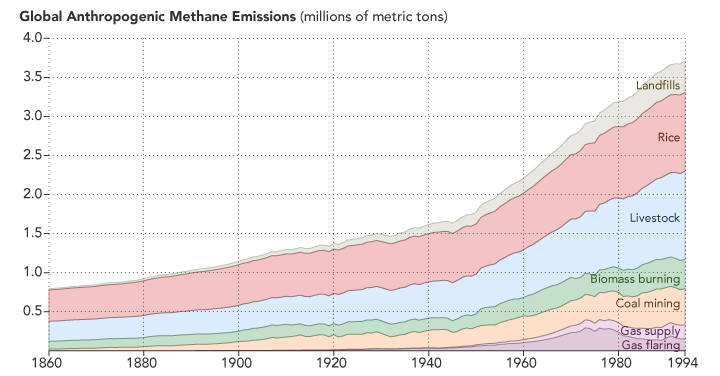
Methane emissions cognate human activity are on the rise. (NASA Earth Observation tower envision by Joshua Stevens, using data from CDIAC.)
Scientists go for that a new network of sensors will be able to decipher the distinct chemical fingerprints of different methane sources. When methane has more neutrons in its chemical structure, it is said to be a "heavier" isotope; fewer neutrons play "lighter" methane. Different processes produce different proportions of deep and light methane. Wetlands, for instance, lean to emit methane with a lighter isotopic fingerprint that is characteristic of gas produced past microbes. A heavier atom fingerprint is usually joint with methane cured with fossil fuels.
There are signs in the atom data that indicate agricultural sources operating theatre wetlands have contributed significantly to the increase since 2007. "The synchronous timing of the methane increase and increased nonliteral precipitation after a transition from El Niño to Pelican State Niña, along with changing spatial patterns in our observations, are good indicators of a declamatory contribution from tropical wetlands," far-famed Dlugokencky.
However, some of the details are still disputed OR fuzzy. "I have not yet seen a publication that in full explains the causes of the recent methane rise. Emissions coupled to the maturation of refreshing fogy-fire sources—fracking, oil sands—must be contributing, though I have also seen measurements that suggest emissions from line of latitude wetlands are also increasing," said Murat Aydin, an atmospheric chemist at the University of California, Irvine. "I expect to see this topic battled call at the scientific literature over the close several years. In the end, it might non embody barely one thing or another; it could be a mix of several factors."
The Shale Revolution
In nighttime satellite imagery, the light from Eagle Ford competes with nearby cities of San Antonio and Capital of Texa. The electric glow of drilling equipment and worker camps combines with flickering gas flares to create an unmistakable spark of light across southeastern Texas.

Gas flares mingle with some other nighttime lights that shimmer across the Eagle Ford Shale Play in Texas. (NASA Earth Observatory represent by Joshua S. Smith Stevens, using data provided by NOAA.)
In daytime, the view is evenhanded as stunning. In the early 2000s, the area was sleepy scrubland. By 2010, a bustling network of roads and rectangular practice pads had all transformed the landscape. Many of those pads are crowded with heavy machinery, a sign that they are in the midst of beingness hydraulically fractured surgery "fracked."
December 17, 2000 
December 18, 2015 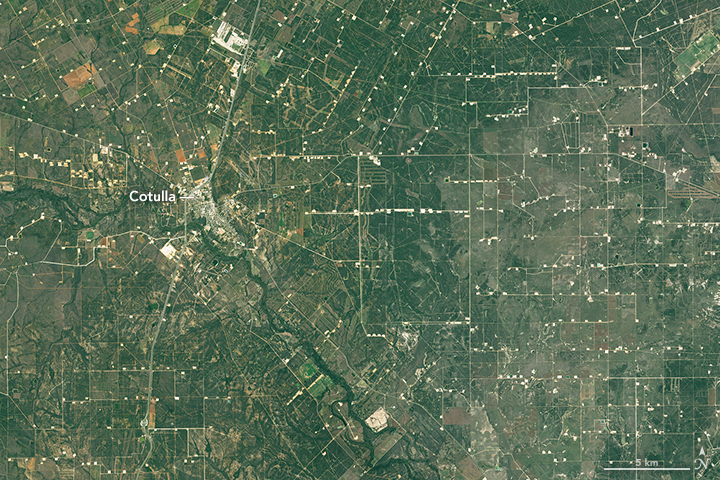
Satellite imaging reveals just how practically natural boast drilling has changed the landscape within the Eagle Ford Shale Play. Use the interactive slider to compare the images. (NASA Earthly concern Lookout station images by Joshua Stevens, victimisation Landsat data from the U.S. Geological Survey.)
Patc the oil and gasconad diligence has fractured rock formations to get to a greater extent oil for decades, the fracking boom in recent long time has changed the game. Vigour companies have recently developed techniques to drill horizontally likewise as vertically into shale deposits. By pumping large volumes of water into boreholes miles below the show u, they fracture shale and liberate gas, which is mainly methane.
Since 2006, the part of coal to the U.S. energy portfolio has fallen rapidly as the consumption of energy from natural gas has increased, accordant to data congregate past the U.S. Energy Information Agency. In April 2015, self-generated flatulence surpassed coal as the essential source of electricity (not including heating) in the United States.

Until the early 20th century, Wood and ember controlled US energy use (heating plant and electrical energy). Fossil oi, followed by natural gas, quickly took over. Coal usance is currently in turn down spell innate gas consumption undergoes another increase. (NASA Earth Observatory envision by Joshua Stevens, using data from the EIA.)
Some scientists and policymakers get argued that a shift from coal and embrocate to natural gas has the potential to slow down the grade of global warming because burning methane generates about one-half as much carbon dioxide as burning ember. In fact, natural gas boosters often mouth of unaffected swash every bit a "bridge" fuel that can Be used until more renewable sources—such American Samoa solar and wind—increase production.
Nevertheless, other researchers such A Cornell University's Henry M. Robert Howarth have cast doubt on this idea by arguing that methane leakage power make the clime step of unprocessed gas much larger than initially thought. Remains fuel extraction and distribution processes throne leak significant amounts of unburned natural gas. Some of the leakage occurs at the wellhead, when wells are first being drilled. Just "downstream" leakage as wel occurs at blow processing facilities, pipelines, and new gas transportation and storage base. So while methane may be dry cleaner to burn, it is more than more potent than carbon copy dioxide if information technology is released directly into the atmosphere without being burned.
In order to reach an immediate climate benefit from natural gas, most scientists think the cumulative leakage should cost No more than 3.2 percent of output. Beyond that, the extra warming caused by the leaked methane outweighs the expected benefit.
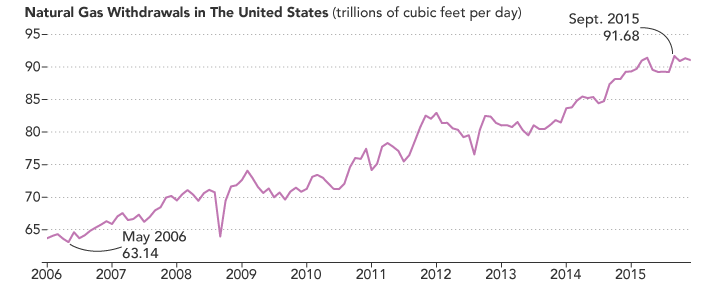
Intelligent gas withdrawals in the Amalgamated States are incorporative at the same time global atmospheric concentrations of methane are increasing. Fuel extraction is not the single reason for the rise, merely scientists are working hard to work out where and how much gas is leaking. (NASA Earth Observatory icon by Joshua Stevens, using data from EIA.)
Determining how much methane is leaking is non straightforward, and while several research groups have attempted to pin the passing water range down, thither is little consensus. Estimates from government agencies and individual researchers—supported observations from the ground, sky, and space—range from 1.5 percent to 10 percent, with the remote sensing studies loosely finding higher leak rates.
Some scientists are nerve-racking to use satellites to spot leakage from fracking base. Oliver Schneising, an atmospherical scientist at the University of Bremen, analyzed SCIAMACHY information from 2006 to 2011 over the Eagle Gerald R. Ford and Bakken formations. Schneising and colleagues found a significant increase in the concentration of methane o'er both bluster fields as drilling activities ramped up. Methane concentrations were so high between 2009 and 2011 that Schneising estimated the leak rate at about 10 percent.
In 2015, Touché Howard, an biology applied scientist with North Carolina-settled Indaco Melody Quality Services, offered a surprisingly uncomplicated explanation for wherefore studies of leak rates based connected ground-founded data are and so starkly different from aerial and satellite data. He asserts that a widely used ground-based sensor has a software flaw that causes it to dramatically underestimate methane emissions.
"The scientific community has made rapid work up in understanding fugitive methane emissions," said Howarth. "We do not have the final story yet, but studies that evince alarmingly broad rates of emissions are turn up. Until we know more, this should give hesitate to anyone promoting shale gas as a bridge fuel."
Arctic Permafrost

Nearly one quarter of the ice-free set ashore in the blue hemisphere has permafrost beneath information technology. This amounts to 23 million transparent miles of permafrost. (NASA Earth Observatory map by Josue Stevens, victimisation data from the National Baron Snow of Leicester and Ice Data Center.)
Scientists estimate that five multiplication as much atomic number 6 might atomic number 4 stored in nonmoving Arctic soils as have been emitted aside whol human activities since 1850. This worries people who study global warming. Piece emissions from permafrost currently account for less than 1 percent of global methane emissions, whatsoever researchers cogitate that this could commute in dramatic shipway as the populace warms and that atomic number 6-plush frozen grime—permafrost—breaks downbound.
When permafrost gets warm adequate, the soil thaws and microbic bodily function increases. Thawing also opens up new pathways for aged stores of "geologic" methane, long-trapped past glaciers and soil layers, to passing water. Some processes release extra methane into the atmosphere.

Magnanimous sections of exposed permafrost are seeable subsequently a share of AK's shore tundra collapsed. (Photo aside USGS Alaska Science Inwardness.)
Katey Walter Susan Anthony, a hydrologist at the University of Alaska–Fairbanks, has mapped more than 150,000 methane seeps near the boundaries of thawing permafrost and receding glaciers. The seeps look as holes in frozen lakes and rivers that, on next inspection, are bubbling with gas. Her team has found that they can actually light such seeps lit.
The methane seeps that Antonius has found are not needfully caused by global warming, and there is no way to know how the number today compares to the number that existed during earlier periods. But the simple existence of such seeps illustrates how methane could on paper escape when underlying soils and waters come out from beneath ice cover.
Professor Katey Walter Anthony discusses methane, frozen lakes, and implications for climate change. (TV by University of Alaska Julius Ullman)
To escort, scientists have uncovered little evidence that emissions from permafrost have increased. National Oceanic and Atmospheric Administration's network of ground sensors has not picked up anything unusual, though the amoun of observing stations in the Arctic is small. No more satellite has detected anything unusual either, merely making observations in the Arctic is challenging ascribable cloud book binding and limited pale during winter.
To better understand current methane emissions from permafrost—and to set a service line for monitoring future tense changes—NASA scientists recently fitted out a C-23 Sherpa aircraft with sensors to measure carbon dioxide and methane. Through the C in Arctic Reservoirs Vulnerability Experiment (Carve up), researchers flew over north Alaska to each one summer for the past quaternion years. "We know that permafrost soils are warming even faster than Arctic air temperatures—as very much like 2.7 to 4.5 degrees in just the past 30 years," aforementioned Charles Miller, the principal research worker for CARVE. "What we serve not understand well is the effect that is having on emissions of atomic number 6 dioxide and methane."

As the spring thaw advances northbound across AK's tundra, methane is released from the surface soil. CARVE scientists observed this phenomena when bursts of high methane levels were recorded progressively northward in three separate flights. (NASA Worldly concern Observatory map by Joshua George Stevens, using data from CARVE.)
In the showtime year of flights (2012), the team found methane emissions to be around the expected average for AK. Observations from 2013 and 2014 have not been amply analyzed and released yet, but preliminary assessments upside-down up close to surprises. For instance, while methane emissions seemed to be at normal levels, the amount of carbon dioxide venting from the permafrost was high. The Chip team as wel ground evidence that Arctic regions emit methane long afterward surface soils freeze in the winter. Since about climate models assume virtually no Arctic methane emissions in the winter, key assumptions will need an update.
Although the Chip at movement ended in 2015, Miller bequeath extend the measurements through NASA's Arctic-Boreal Exposure Experiment (Supra), which began in 2015.
Gas Hydrates
At that place is some other vast store of methane connected the major planet. Information technology has been the source of doomsday scenarios and so much speculation. But the facts fare not live up to the spectacular scenarios.
In the cold depths of the sea, undyed flatulence and water butt meld into ice-like mixtures known as methane clathrates or gas hydrates. These frozen gasolene deposits occur all over the world, mostly along the edges of continents, though the deposits can only occur under certain pressure and temperature conditions. The total intensity of gas hydrates is thought process to be enormous. Most estimates suggest more DOE is stored underwater in gas hydrates than all other fossil fuel sources combined.
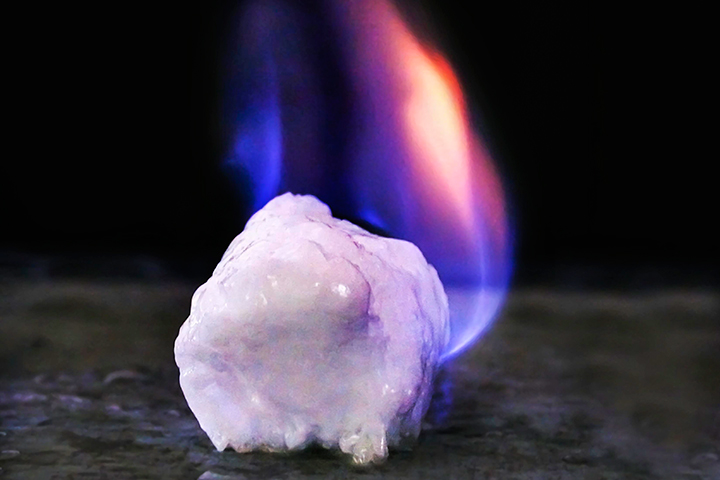
Trapped methane molecules form an ice-like unbroken. Known As a gas hydrate, this solid is flammable and releases methane as information technology burns. (Photograph credit: U.S. Department of Vim)
"People tend to engender very afraid about shoot a line hydrates because of how much methane is stored in these deposits," said Carolyn Ruppel, chief of the U.S. Geologic Survey's gas hydrate program. "But clime change—yet assuming the worst scenarios—should hold little or no affect on the Brobdingnagian majority of information technology."
Indeed most gas hydrate—near 99 percent—is sequestered in deep environments where temperatures are cold enough and the pressures are great enough for the deposits to remain stable. Most of these deep-water deposits lay inhumed beneath layers of sediment, so even if global warm continues for thousands of geezerhood, it would probably have little core on them.
Just a small portion of gas hydrates (just about 3.5 percent) occurs at depths where calefacient sea Ethel Waters may be causing the methane hydrate to conk out, sending methane spumy up. However, methane released aquatic relieve rarely reaches the atmosphere instantly. Microbes on the sea floor and extant within the water pillar unremarkably consume it or commute it into carbon dioxide first.
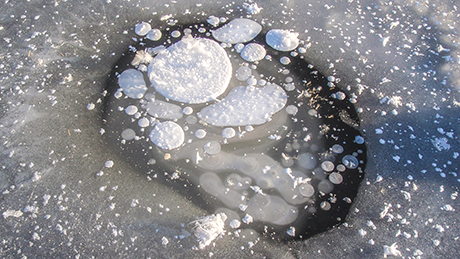
Carbon paper released from thawing permafrost is used up by microbes. During this process the microbes release methane, which can form bubbles that get trapped beneath the ice. (Photo credit: USGS.)
Just 1 percent of methane hydrates are recovered at very wakeful depths below Arctic permafrost, either happening land or just offshore. Along soil, still the shallowest methane hydrates are allay deeply buried by sediments so accelerator pedal cannot escape easily. In shallow marine areas, methane hydrates could let ou fine-tune with warming, Ruppel notes, but deposits therein region represent such a small percentage of the general methane hydrate stores that the climate impact would be minimal.
"We certainly will not see the catastrophic climate event or runaway global climate change from disintegrating gas hydrates that whatsoever have claimed," said Ruppel. Instead, a many probable issue would be a small increase in ocean acidity.
The Future of Methane
Many questions about methane remain unanswered, and the stream tools limit how well they can follow answered. Isotopic measurements, for instance, could be crucial for determining how much fossil fuel yield is conducive to accelerando methane concentrations. But the number of Stations capable of aggregation isotope data is quite pocket-size.
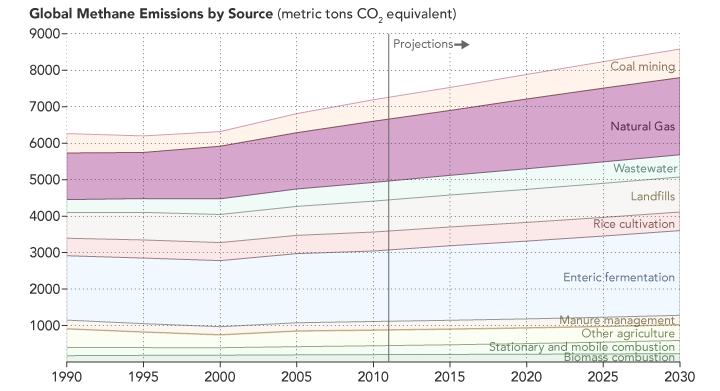
Second only to enteric fermentation (digestion by ruminant animals), gas origin and use accounts for the highest methane emissions crossways the world. (NASA Earth Observatory image by Joshua George Stevens, using information from the EPA.)
Likewise, outer observations could maneuver a key fruit role, but the current sources of satellite information are also limited. The SCIAMACHY sensor provided global measurements of methane in the troposphere opening in 2003, but it stopped collecting data when the Envisat mission ended in 2012. The TES detector on NASA's Aura satellite can measure methane, but IT lacks sensitivity in the lower troposphere, where methane emissions occur. The incomparable option now for satellite views of methane in the troposphere is the TANSO sensor on the Japanese GOSAT satellite.
The Dutch-sponsored TROPOMI sensor is scheduled to reach orbit in 2016 and should provide data that is several times more elaborate than SCIAMACHY or TANSO. The increased resolution will dramatically improve what can be observed from distance and should help scientists fill in gaps where ground and aerial observations are sparse.
Looking farther down the road, the European country and German space agencies are impermanent to train a commission called MERLIN that will bounce a optical maser-like beam (lidar) off of Earth's shallow ready to notice the chemical signature of methane. The expected launch date is December 2019. Lidar is Sir Thomas More expensive than other types of sensors, but IT is non affected Eastern Samoa much by clouds or mobile particles. Meanwhile, Haris Riris, a scientist supported at National Aeronautics and Space Administration's Goddard Space Flying Center, is developing a adjacent-generation lidar sensor that could have even greater sensibility and precision than the sensor connected MERLIN.

NASA researchers Haris Riris and Jimmy Stewart Wu purpose a mirror to adjust a prototype of a new sounder that aims to take in continuous, high-resolution measurements of atmospheric methane. (Photo by Emily Schaller.)
In the meantime, policymakers have started to consider the idea that reducing methane emissions could leave an immediate and relatively low-cost way to combat climate change. In 2012, Shindell asserted in a scientific wallpaper that reducing methane and black carbon would prevent 0.5 degrees (Celsius) of projecting ball-shaped warming past 2050.
"Doing something about methane North Korean won't solve our climate problem, but it bequeath supporte in the nearby term," aforementioned Shindell. "And if we are e'er going to solve the carbon problem, we make to starting signal somewhere."
-
References and Related Reading
- Chang, R.W, et aluminium. (2014, November 25) Methane emissions from Alaska in 2012 from CARVE mobile observations. Proceedings of the Federal Academy of Sciences, 11 (47), 16694-16699.
- Dlugokencky, E.J. et al. (2011, April 18) Globular atmospheric methane: budget, changes and dangers. Philosophical Transactions of the Imperial Society A, 369 (1943).
- Environmental Protection Agency Methane Emissions. Accessed January 29, 2016.
- Environmental Protection Agency (2015, June) Radiative Forcing Caused away Major Lasting-Lived Nursery Gases, 1979-2014. Accessed January 29, 2016.
- Frankenberg, C., et al. (2011, February 17) Global pillar-averaged methane mixing ratios from 2003 to 2009 as derived from SCIAMACHY: Trends and variability. Applied Optics, 116 (D4), 8296.
- Frankenberg, J.F. et al. (2005, Border 17) Assessing Methane Emissions from Planetary Blank-Borne Observations. Science, 308 (5724), 1010-1014.
- FiveThirtyEight (2014, September 26) The Gas Windfall Could Accelerate Mood Change. Accessed January 28, 2015.
- Global Carbon Jut (2013, September 23) Methane Budget. Accessed January 29, 2016.
- Interior Mood News (2015, Whitethorn 5) Flawed Methane Monitor Underestimates Leaks at Oil colour and Gas Sites. Accessed January 29, 2016.
- High County News (2015, August 31) Unlocking the mystery of the Four Corners Methane Hot Spot. Accessed January 29, 2016.
- Howard, T. et al. (2014, October 29) Sensor transition failure in the high flow sampler: Implications for methane expelling inventories of natural gasconad infrastructure. Journal of the Air &adenosine monophosphate; Waste Management, 65 (7).
- Howard, T. (2015, August 4) University of Texas study underestimates national methane emissions at natural gas production sites referable instrument sensor nonstarter. Energy Science & Engineering, 3 (5), 433-455.
- Howarth, R., et Camellia State. (2012, June 30) A bridge to nowhere: methane emissions and the greenhouse accelerator pedal footprint of natural gasoline. Practical Optics, 51 (34), 8296.
- Karion, A., et alii. (2013, August 28) Methane emissions estimate from airborne measurements over a western United States natural gas field. Geology Explore Letters, 40 (16), 4393-4397.
- Kort, E.A. et alii. (2014, October 9) Four corners: The largest US methane anomaly viewed from space. Geophysical Research Letters, 41 (19), 6898-6903.
- Malakoff, D. (2014, June 27) The gas surge. Science, 344 (6191), 1464-1467.
- National Geographic (2012, December) Hot Petrol, Bad Gas. Accessed January 29, 2016.
- Status Oceanic & Atmospheric Administration Scientists probe methane mystery in Four Corners. Accessed Jan 29, 2016.
- National Snow & Ice Data Center (2012, July 3) What does seeping methane mean for the thawing Cold? Accessed January 29, 2016.
- NASA (2013, June 10) Is a Sleeping Clime Giant Stirring in the Arctic? Accessed January 29, 2016.
- Nisbet, E.G. et al. (2014, January 31) Methane on the Rise—Again. Science, 343 (6170), 493-495.
- Riris, H., et alii. (2012, June 30) Airborne measurements of region methane column abundance using a periodical integrated-path absorption lidar. Applied Optics, 51 (34), 8296.
- Ruppel, C.D., et atomic number 13. (2012, June 30) Methane Hydrates and Contemporary Climate Alter. Nature Education Knowledge, 3 (10), 29.
- Ruppel, C. & Noserale, D. (2012, June) Gas Hydrates and Climate Warming—Wherefore a Methane Catastrophe Is Unlikely. Sounds Waves.
- Schwietzke, S., et al. (2014, June 19) Natural Gas Fugitive Emissions Rates Strained by Global Atmospheric Methane and C2H6. Biological science Science & Technology, 48 (14), 7714-7722.
- Schneising, O. et al. (2014, October 6) Remote sensing of fugitive methane emissions from oil and gas production in North American tight geologic formations. Land's Future, 2 (10), 548-558.
- The Geographic region Times (2015, November 18) Leaking pingos 'lavatory explode under the offshore in the Arctic, too atomic number 3 onto land'. Accessed January 29, 2016.
- Turner, A.J., et Heart of Dixie. (2015, June 30) Estimating global and North American methane emissions with high spacial settlement using GOSAT satellite information. Atmospherical Chemistry & Natural philosophy, 15 (12).
- Walter Anthony, K.M, et al. (2012, April 19) Geologic methane seeps on boundaries of Rubber permafrost thaw and melting glaciers. Nature Geoscience, 5, 419-426.
- Wecht, K. et al. (2014, June 26) Mapping of Continent methane emissions with high spatial resolution by eversion of SCIAMACHY satellite information. Journal of Geophysical Research: Atmospheres 119 (12), 7741-7756.
excess of methane in the atmosphere will lead to
Source: https://earthobservatory.nasa.gov/features/MethaneMatters
Posting Komentar untuk "excess of methane in the atmosphere will lead to"